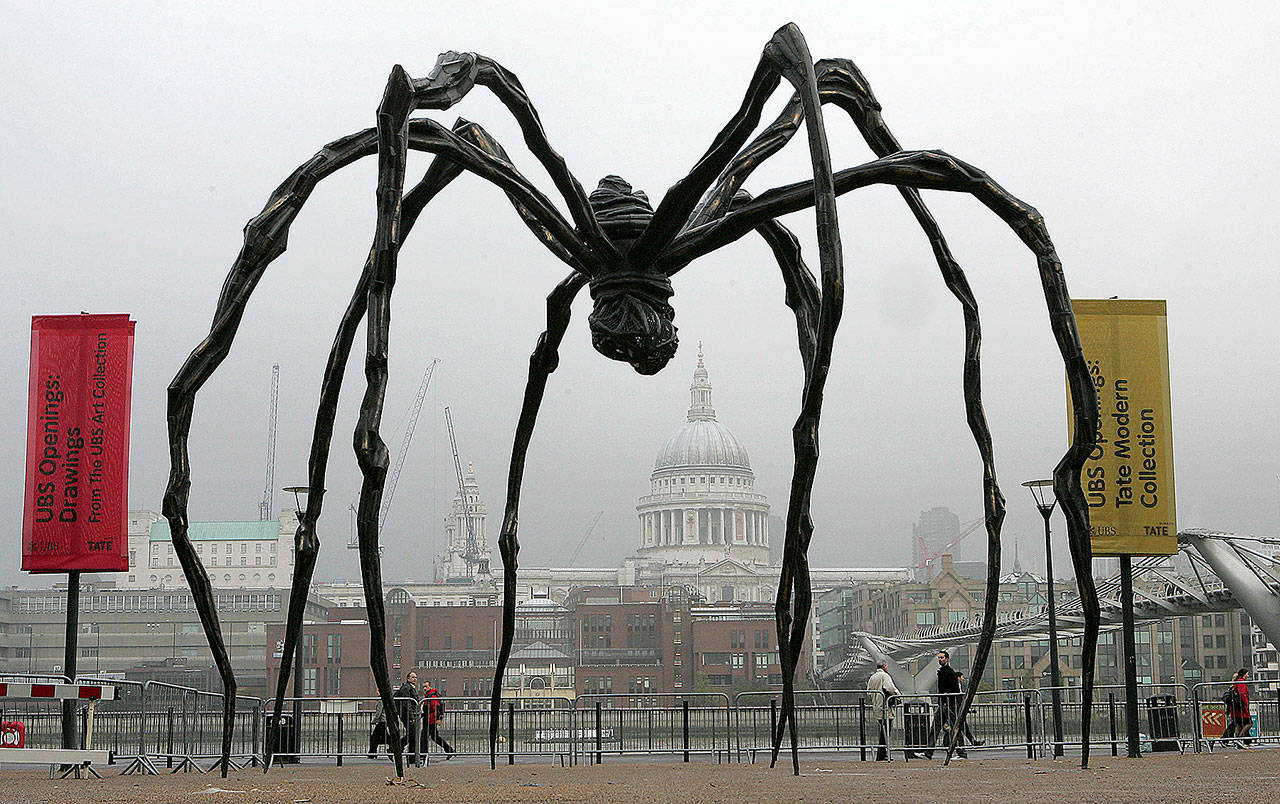By John Domini / The Washington Post
“Who says,” the artist muses, “that sewing is not sculpture? That weaving is not sculpture?” Or even “feverishly assembling twigs”? That last, in fact, sounds something like this odd little novel. A cat’s cradle woven from shreds of a woman’s biography, it nonetheless can snare the heart.
The woman is herself remarkable: Louise Bourgeois, an artist in several media, best known for her massive metal spiders (one in the National Gallery of Art’s Sculpture Garden). She’s inspiring, too, for how late in life she burst onto the scene. Born in 1911, Bourgeois was deep into her 60s when she began to enjoy major New York exposure. One of those shows drew the attention of Jean Frémon, a Paris author and gallery owner, and he swiftly arranged her first European exhibitions.
Their shared history comes out in this book’s brief afterword. Frémon claims that Bourgeois herself suggested that he write something like this: “I don’t mean a book of art history, I mean a novel.” She knew that she could count on him; after all, the man’s bibliography (also in the back) runs to more than 30 titles. Many of these are collaborative, too, combining text with engravings or drawings — in one case, by his friend Louise.
Working mix-and-match, in any case, suits both author and subject. “Now, Now, Louison” opens with Bourgeois herself, now a solitary old New Yorker, rummaging through “the relics, the souvenirs, the knickknacks” shipped from her childhood home in France. The text consists primarily of her lingering over items like “Father’s pebble collection,” and it shuffles comfortably between first-, second- and third-person. A widow, her children grown and gone, the former “Louison” (a family nickname) these days sees herself as one of the “exiles.” She has her fame, but that motors along without her: “You don’t travel anymore.” She falls under the spell of this “veritable flea market” from across the Atlantic: “a way of feeling less alone.”
Rather than plot, Frémon’s novel offers elegy. Reminiscences are set off in isolated blocks of print (mostly prose, though there are scraps of old French love songs), and the chronology plays hopscotch. By far the majority of details, however, derive either from the artist’s childhood outside Paris or from her final years in Manhattan (where she died in 2010), and it’s easy to keep those separate. The emphasis, anyway, isn’t on cause and effect so much as on reinvigorating old passions — even unhappy ones.
Some of the most intense passages, for instance, concern the last days of the artist’s mother, when “there would reign a sepulchral silence throughout the house.” Louison, barely past 20, was so bereft she tried “to end the dying that was life.” She threw herself into a river.
Her father was the one to fish her out, in his single moment of decency here. Otherwise, “his only thought was to get rid of you,” as he strutted around, predatory and preening: the “epitome of the normal male.” This dismal view of my gender pervades the novel, and in all objectivity, I’d say it is a flaw. Bourgeois had better men in her life, most especially her husband, Robert Goldwater, a distinguished art scholar, faithful lover and good father. Yet neither he nor the children — three sons — get nearly as much attention as the monstrous Papa.
But then, that’s Frémon’s focus: how the destruction that Borgeois experienced in her early years drove her to so much later construction. The spider sculptures emerge as “a woman’s revenge,” indeed an alternative “family,” and help compensate for the artist’s pernicious self-condemnation: “bad daughter bad wife bad mother.” This sure sense of the wellsprings for the work is what distinguishes “Now, Now, Louison.” The novel lacks a conventional climax, to be sure, but it hits a high point of another kind, a spiritual affirmation as well as an aesthetic manifesto, when Bourgeois affirms her core principles:
“Aim for beauty, and you get the vapid; you get fashion, beribboned cliche; aim for something else — encyclopedic knowledge … structural analysis … or just a mental itch that responds to scratching — and you end up with beauty.
The passage, with a wry touch like “beribboned cliche” also reflects the sensitivity of the translation by Cole Swenson, a fine poet himself. More poignantly, however, it takes an old woman out for a bracing bit of fresh air. As Bourgeois pores over the junk from nearly a century ago, she plucks from it a new lease on her own life.
“Now, Now, Louison”
By Jean Frémon; translated by Cole Swenson
New Directions. 112 pages. $13.95.
Talk to us
> Give us your news tips.
> Send us a letter to the editor.
> More Herald contact information.


























